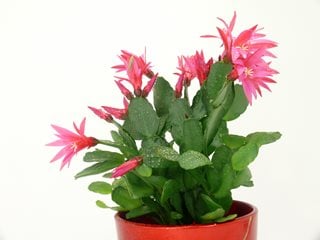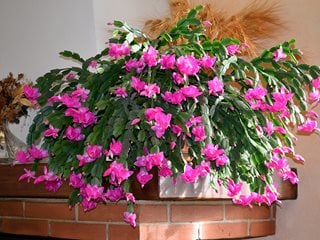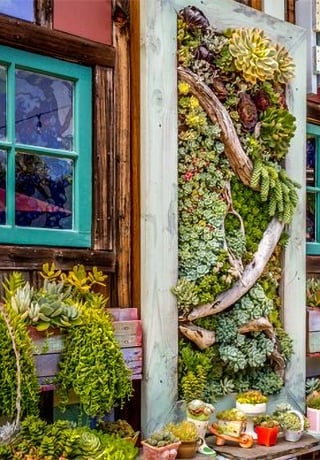How to Care for a Christmas Cactus
Care and growing tips for Christmas cactusA favorite holiday plant, Christmas cactus are succulents that are usually grown as houseplants. Readily found in garden centers and stores in mid-fall, Christmas cactuses get their name from the time of year they bloom. They do require special attention to encourage blooming, but otherwise are fairly easy to care for.
CHRISTMAS CACTUS CARE
Here are tips to help you care for your Christmas cactus:
- Keep them in filtered (not direct) sunlight. For the majority of the year, keep them in bright, but indirect light—except when trying to set flower buds. (More on that below.)
- Repot only every two to three years. They prefer to be slightly pot-bound, so leave them be for a couple years at a time, repotting them in spring or early summer, never in fall when trying to get them to set buds. Watch for yellowing stem sections, as this can be a sign that your plant is not getting enough nutrients from overcrowding.
- Check water weekly. Water only when the top one to two inches of soil feels dry to the touch. Soak until water runs through the pot and out the drain hole. Empty the saucer or reservoir of any remaining water. Overwatering can be the biggest problem, causing stem and root rot, as well as bud or flower drop.
- Provide good soil and drainage. Plant using a good quality cactus mix with plenty of perlite. Planting in a clay pot with drainage will allow water to drain and evaporate better than a plastic pot, keeping the soil from staying overly wet.
- Provide humidity. Being rainforest natives, they like a humid environment. If you live in a dry climate, raise the humidity around the plant by placing the pot in a saucer filled with pebbles and water. Just make sure that the water doesn’t touch the bottom of the pot. As the water from the saucer evaporates, it increases the humidity around the plant.
- Apply a water-soluble fertilizer. Starting when new growth appears in spring until fall, apply a water-soluble fertilizer for flowering houseplants, following the package directions for frequency and dosage. Don’t apply fertilizer when trying to get buds to set or when in bloom.
- Move outside. Plants can be placed outside in late spring and summer, just not in direct sunlight. Be sure to get them back inside before any freezing temperatures arrive.
- Prune them back. If your plant is getting too large or leggy, they are easily pruned by cutting in between stem sections or twisting between the segments.
- Pruned-off sections can be easily propagated. Let the pieces sit for a few days, allowing the cut ends to callus over. Place the callused ends about ½” deep into a pot with cactus mix potting soil. Water gently, and in a few weeks, you should see new roots sprouting.
HOW TO GET A CHRISTMAS CACTUS TO BLOOM
The hardest part of caring for a Christmas cactus is getting it to re-bloom. Here are some tips to get you on the right track:
- Cut back water. In early-to-mid fall, start cutting back slightly on water; this will help trigger dormancy, which is vital to getting your plant to re-bloom.
- Keep it dark 12 to 14 hours a day. They are extremely sensitive to light, especially when trying to get buds to set. Even a room lamp or streetlight outside a window can have a detrimental effect. Find a dark closet and keep the door closed, or cover it with a black bag or cloth overnight, 12 to 14 hours.
- Keep in a cool area. Temperature should be cool, about 50 to 55 F at all times.
- Continue the light and temperature control for at least 6 to 8 weeks, or until you see buds begin to form.
- Relocate once buds have formed. You can now move your plant back to its original location with indirect sunlight, making sure it's free of cold drafts or warm air.
- Resume regular watering. Keep in mind that too much water can cause bud drop.
- Be patient. It can take up to 12 weeks to bloom once the buds have formed.
CHRISTMAS CACTUS vs. THANKSGIVING CACTUS
Most “Christmas cactus” seen in stores during the holiday season are actually Thanksgiving cactus (Schlumbergera truncata) because they bloom slightly earlier than true Christmas cactus (S. bridgesii or S. xbuckleyi). Both are often referred to as holiday cactus or Zygocactus, confusing them even further. Their care is the same, so it's not critical to tell them apart, but here's how:
CHRISTMAS CACTUS PROBLEMS
A few hints to help you troubleshoot common problems:
- Red stem segments can mean too much sun or not enough water.
- Yellow stem segments can also be a sign of too much sun, too much water, or not enough nutrients caused by overcrowding in pot.
- Bud and flower drop can be caused by a sudden change in light, temperature (cold drafts or warm air from heaters), or moisture level. Adjust the location or watering.
- Black and slimy areas can mean fungal or bacterial disease. There is usually no cure for this at this stage, best to throw out the plant to keep it from spreading and start over.
- A woody stem is simply a sign of an aging plant.
CHRISTMAS CACTUS BASICS
Origin: Native to rainforests and coastal mountains of southeast Brazil; found in nature attached to trees and rocks, not growing in soil.
Growth rate and size: Can reach a spread of 2 feet within just a few years. Thanksgiving and Christmas cactuses can last for years, even decades.
Foliage: Green ‘leaf pads’ are actually stem sections.
Flowers: Bloom in a variety of colors, including fuchsia (most common) and pink, red, white, or yellow.
Toxicity: Not toxic to dogs or cats, although the fibrous plant material can cause stomach irritation.

Easter cactus. Photo by TwilightArtPictures / Shutterstock.
WHAT ABOUT EASTER CACTUS?
To further confuse the issue, there’s a third plant, Easter cactus (Rhipsalidopsis gaetneri) that looks very similar to a Thanksgiving or Christmas cactus, but is actually from a completely different plant group. They can be distinguished by the more subtley scalloped stem segments and star-shaped flowers. Easter cactuses bloom in spring around Easter time.
RELATED:
Colorful Poinsettia Plants that Pop
Guide to Growing Beautiful Amaryllis



